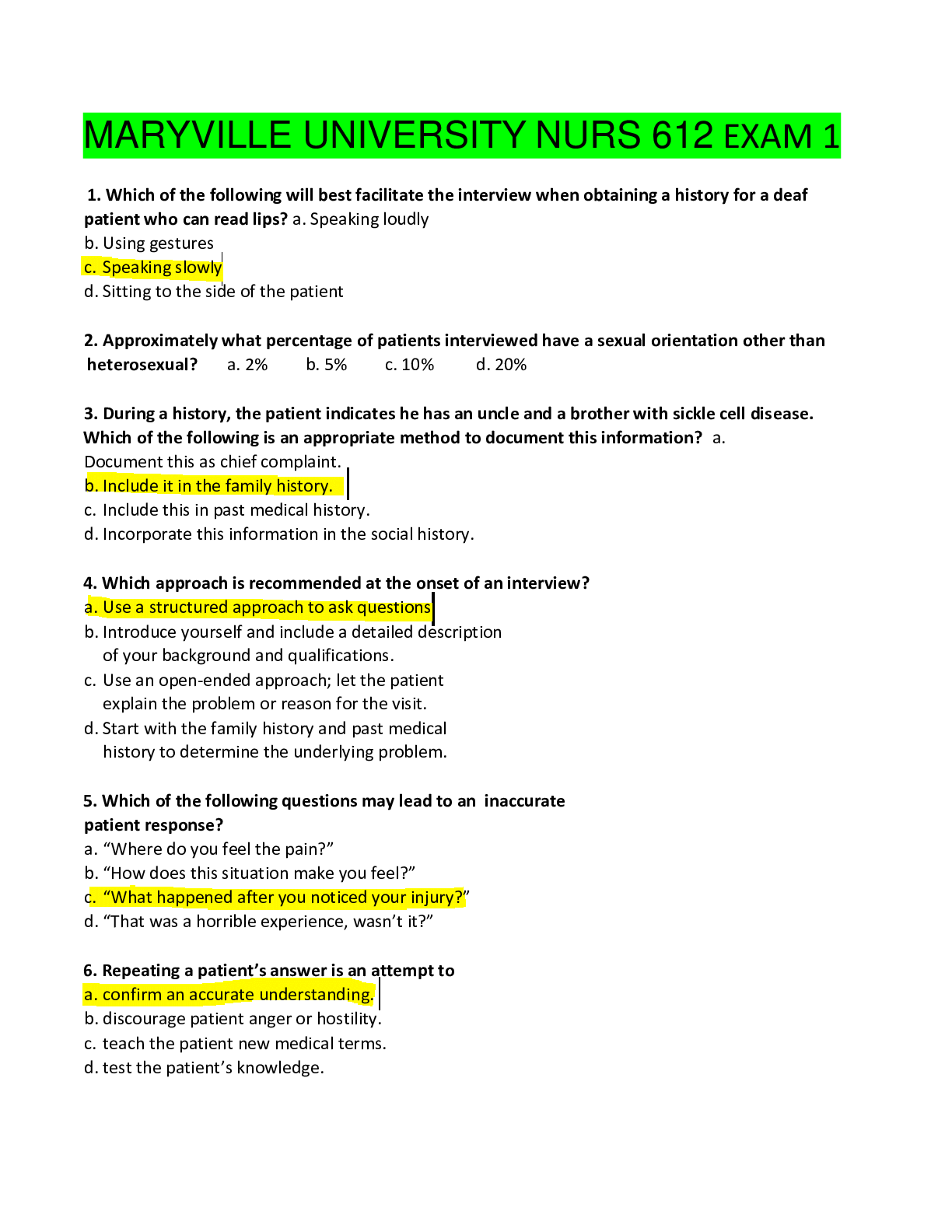Management > QUESTIONS & ANSWERS > WGU D080 Managing in a Global Business Environment, Top Exam Questions and answers, rated A+ (All)
WGU D080 Managing in a Global Business Environment, Top Exam Questions and answers, rated A+
Document Content and Description Below
WGU D080 Managing in a Global Business Environment, Top Exam Questions and answers, rated A+ The key element of globalization is interdependence and interconnectedness among companies and count... ries around the globe. Globalism is characterized by an increasing number of worldwide connections, rapid and discontinuous change, an increasing number of diverse participants, and growing complexity. What is globalization? economic: developed economies integrating with developing countries through foreign direct investment, lowering the costs of doing business, reducing trade barriers, and, in many cases, increasing cross-border migration. political: globalization may ultimately reduce the importance of nation-states. cultural: The spread of culture has added to processes such as commodity exchange and colonization, which have a more extended history of carrying cultural meaning around the globe. The circulation of cultures enables individuals to partake in extended social relations that cross national and regional borders. What are the economic, political, and cultural effects of globalization? 00:0201:23 any nonprofit, voluntary citizens' groups that are organized on a local, national, or international level What is nongovernmental organization and how does it impact government public policy across national boundaries? International business encompasses a full range of cross-border exchanges of goods, services, or resources across two or more nations. These exchanges can go beyond the exchange of money for physical goods to include international transfers of other resources such as people; intellectual property such as patents, copyrights, brand trademarks, and data; and contractual assets or liabilities. Such assets or liabilities include the right to use some foreign asset, provide some future service to overseas customers, or execute a complex financial instrument. The entities involved in international business range from large multinational firms with thousands of employees doing business in many countries to a small one-person company acting as an importer or exporter. This broader definition of international business also encompasses for-profit, border-crossing transactions as well as transactions motivated by nonfinancial gains. What are the features of international business? - Exporting - franchising - joint ventures - home-owned affiliates - fully global ventures What are the different forms of international business? Explain each form. 1. market entry 2. product specialization 3. value chain disaggregation 4. value chain reengineering 5. creation of new markets What are the 5 stages of entering a global market? Explain each stage market, cost, competition, government What are the 4 drivers of globalization? Explain unsaturated demand for new products, lower labor costs, less expensive natural resources, and other inputs to products. What are the benefits and costs of global expansion from MNCs' perspective? 1.0: the first stage of globalism and is pushed forward by nationalism and religion. 2.0: the second stage of globalization and is characterized by advances in methods of transportation. 3.0: the third stage of globalization and is characterized by advancements across the board, especially technology and communication. What are the characteristics of each stage of globalization? Ethical issues, governmental policies, and economic restrictions are all likely when a company moves into an unfamiliar global space. A multinational company may also face infrastructural and technological challenges in a developing country. What are the criticisms of globalization? There are more than 13 major types of government, each of which consists of multiple variations. At one end of the extremes of political ideologies is anarchism, which contends that individuals should control political activities, and public government is both unnecessary and unwanted. At the other extreme is totalitarianism, which contends that every aspect of an individual's life should be controlled and dictated by a strong central government. Totalitarianism Authoritarian Monarchy Democracy Oligarchy Dictatorship What are different types of governments? Explain Local policies, rules, and regulations can have a significant effect on the success rate of a business. Depending on how long a company expects to operate in a country and how easy it is for business to enter and exit, a firm may also assess the country's political risk and stability. What impacts does a political system have on international trade and business? 00:0201:23 - Industrialized nations have economies characterized by a healthy climate for private enterprise (business) and by a consumer orientation, meaning the business climate focuses on meeting consumers' long-term wants and needs. - Less-developed nations, also known as least-developed countries (LDCs), have extensive poverty, low per capita income and standards of living, low literacy rates, and minimal technology. - Developing nations are those that make the transition from economies based on agricultural and raw materials production to industrialized economies. What are the features of industrialized, less-developed, and developing nations? - Traditional economies are found in rural countries where the primary occupation is farming. - In a command economy found in a communist country, most of the economic system is controlled by a centralized power. - In a planned economy found in a socialist country, the factors of production are used for the common good. - In an open economy, a democratic method is used to determine how to use the factors of production. - A market economy is a decentralized economy in which firms and households determine how resources are allocated based on how best to satisfy their needs. - A mixed economy has less government intervention than a command economy. Supply and demand control the economy, and ideally, the government steps in when needed. What are different economic systems and how to differentiate them? - Communisim is a system in which all property is publicly owned and the government controls global trade - Social ownership, central control of the means of production, and a cooperative approach toward management of the economy are hallmarks of socialism. - Capitalism is generally considered to be an economic system based on private ownership of the means of production and on the creation of goods or services for profit by privately owned business enterprises. What is communism, socialism, and capitalism? - civil law system is an inquisitorial system where the investigating judge investigates the facts of the case. It is the most widespread legal system in the world. - Common law is based on traditions and precedence and can be traced to the English monarchy. In common law systems, judges interpret the law, and judicial rulings can set precedent. - Religious law is also known as theocratic law and is based on religious guidelines. Explain and differentiate common, civil, and theocratic legal systems. - The IMF helps maintain liquidity of global funding by providing a straight-forward method for nations to borrow and loan to each other through a mechanism called the special drawing right. - The World Bank's priorities are to help build sustainable economic growth, invest in people, and build resilience for shocks and threats. - WTO reviews the trade policies of all nations to ensure that each country is treated fairly and equally under the most favored nation requirement. - Criticisms are similar: a lack of transparency; neglect for considering the environment when making decisions; and policies in favor of more affluent, developed countries at the expense of poorer nations Identify and differentiate the IMF, the World Bank, and the WTO's major functions and conditionality. Explain criticisms of each international organization. - mercantilism, a zero-sum theory advocating for each country to maintain a trade surplus. - Adam Smith's absolute advantage in which a country exports the goods it can make more efficiently or more cheaply. - Ricardo's comparative advantage which extends the theory to show benefits as long as each country exports the product it is comparatively more efficient at or can produce more cheaply and imports the others - Heckscher-Ohlin which states that competitive advantage comes from differences in natural resources. -Leontief Paradox - Country Similarity Theory - Global Strategic Rivalry Theory List and explain each international trade theory. Focus on the features of each theory. Technology and trade are two mechanisms to increase productivity, which lead to more products and ultimately to lower prices. it takes fewer resources to produce a product. a good can be produced at a lower cost in terms of other goods. What are the two mechanisms to increase productivity? Explain. - many assumptions are made in this theory. - The benefits of specialization may be overstated if the transportation costs are not taken into account. - There is an increasing opportunity cost with increased specialization as less than ideal conditions or natural resources must be used. - Unemployment may be higher with complete specialization because it would be difficult for workers to transfer from one role to another. - Organizations may not recognize that their comparative advantage has changed over time as conditions change. - technology may make it possible for countries to produce many or even most products using an economy of scale, which makes comparative advantage an obsolete concept What are the criticisms of comparative advantage theory? By specializing, countries would generate efficiencies because their labor force would become more skilled by doing the same tasks repeatedly. Production would also become more efficient because there would be an incentive to create faster and better production methods to increase the benefit from specialization. Specialization leads to increased productivity, which can in turn lead to increased unemployment. What is specialization and what is the impact of it? Economies of scale increase the available variety of goods for consumers and decrease the average cost of these goods. Economies of scale can result from the ability to divide labor into smaller parts, which allows for increased specialization. What is the definition and impact of the economies of scale? - Export refers to the selling of goods and services produced in the home country to other markets. - Imports are defined as purchases of goods or services by a domestic economy from a foreign economy. Define exporting and importing - Import tariffs are taxes on goods that are imported into a country. - Export tariffs are taxes on goods that are leaving a country. Taxing exports may be implemented to raise tariff revenue or restrict the world supply of a good. - Protective tariffs are tariffs levied to reduce imports of a product and protect domestic industries. - Revenue tariffs are tariffs levied to raise revenue for the government. - Specific tariffs are tariffs that levy a flat rate on each item imported. - Ad valorem tariffs are tariffs based on a percentage of the value of each item. - Compound tariffs are tariffs that are a combination of specific tariffs and ad valorem tariffs. List and explain types of tariffs. If foreign goods can be sold at a lower price than domestic goods, consumer demand will go up, but the domestic price will do down. The decrease in price drives down the profit margin for domestic suppliers. With tariffs, domestic producers and the government gain and consumers and foreign producers lose overall How does tariff impact the price of imported product, consumers, domestic businesses, and the government? - An absolute quota is a limit on the number of specific goods that may enter a country during a certain period. - A tariff-rate quota is a two-tier quota system that combines characteristics of tariffs and quotas. Under a tariff-rate quota system, an initial quota of a good is allowed to enter the country at a lower duty rate. Once the initial quota is surpassed, imports are not stopped; instead, more of the good may be imported, but at a higher tariff rate. What are the types of quotas? Voluntary export restrictions are a form of trade barrier by which foreign firms agree to limit the number of goods exported to a particular country. What is the Voluntary Export Restraint (VER)? Government procurement programs, Export subsidies, Countervailing duties What are the trade barriers that involve direct government intervention? Free trade can increase the wages and availability of jobs in some sectors but have the opposite effect in other sectors. Due to industry specializations, many workers are displaced and do not receive retraining or assistance finding jobs in other sectors. The nature of industries and trade increases economic inequality. As a result of unskilled workers, the wages within the various industries may decline. How does free international trade impact manufacturing jobs in developed nations? Free trade is a policy by which governments do not discriminate against exports and imports. There are few or no restrictions on trade, and markets are open to both foreign and domestic supply and demand. What is free trade agreement? The WTO is the largest international trade organization, replacing the General Agreement on Tariffs and Trade (GATT) in 1995 and designed to enable international trade while reducing unfair practices. NAFTA, EU, Mercosur, ASEAN What are the international organizations that handle international trade agreements? The General Agreement on Tariffs and Trade (GATT) consists of a set of promises or commitments that countries make to each other regarding their trade policies. The goal of GATT is to make trade freer, and thus, the promises countries make must involve reductions in trade barriers. What is GATT? Protect domestic industries and employment Protect against unfair trade practices Protect national security Identify and explain political, economic, and social rationale of managing international trade from government's perspective. - Portfolio investment refers to act of investing in a company's stocks, bonds, or assets, but not to control or direct the firm's operations or management. Typically, investors in this category are looking for a financial rate of return, as well as for diversifying investment risk through multiple markets. - Foreign direct investment (FDI) refers to an investment in or the acquisition of foreign assets with the intent to control and manage them. Companies can make FDIs in several ways by purchasing the assets of an international company; investing in the company or new property, plants, or equipment; or participating in a joint venture with a foreign company, which typically involves an investment of capital or know-how. FDI is primarily a long-term strategy. Define and compare portfolio investment and foreign direct investment. governments seek to limit or control FDI to protect local industries and critical resources (oil, minerals, etc.), preserve the national and local culture, protect segments of the domestic population, maintain political and economic independence, and manage or control economic growth. Identify the reasons that governments restrict or promote FDI. - Horizontal FDI occurs when a company is trying to open a new market—a retailer, for example, that builds a store in a new country to sell to the local market. - Vertical FDI is when a company invests internationally to provide input into its core operations— usually in its home country. A firm may invest in production facilities in another country. When a firm brings the goods or components back to its home country (i.e., acting as a supplier), this is referred to as backward vertical FDI. When a firm sells the goods into the local or regional market (i.e., acting as a distributor), this is termed forward vertical FDI. Define two forms of FDI. Give an example for each. - Greenfield FDIs occur when multinational corporations enter into developing countries to build new factories or stores. - A brownfield FDI is when a company or government entity purchases or leases existing production facilities to launch a new production activity. Define greenfield and brownfield FDIs. Give an example for each. FDIs benefit both developing and developed nations by increasing jobs and bringing capital to the most successful companies. - An inflow of capital can benefit the global and local economy. - Invested capital goes to businesses with the highest potential for growth. - The profit motive is color blind, and investments are made regardless of religion or politics. - Investors can decrease their risk by diversifying - Investing capital in firms can lead to growth and subsequently increased jobs. What are the benefits of FDI? Governments are careful not to allow foreign ownership of strategically important industries as this could lower the competitive advantage of the nation. Foreign investors could also take advantage of the company they are investing in and take away all valuable assets then leave the country What are the costs of FDI? Horizontal FDI occurs when a company is trying to open a new market—a retailer, for example, that builds a store in a new country to sell to the local market. Vertical FDI is when a company invests internationally to provide input into its core operations—usually in its home country. What is the difference between horizontal and vertical FDI? MNC is a company that operates in two or more countries, leveraging the global environment to enter new markets to increase revenue. Define multinational companies. GCC Which agreement was created in 1981 among Arab states, to expand trade, economic growth, and development and to promote social welfare, peace, and stability? Economic integration is an agreement among nations to reduce or eliminate trade barriers among the nations at a minimum and to have a single political, economic, and trade policy identity at its maximum. Define regional economic integration -free trade area: most basic form of economic cooperation. Member countries remove all barriers to trade between themselves but are free to determine trade policies with nonmember nations independently. The key characteristic is no internal tariffs. (NAFTA). - Customs unions: economic cooperation as in a free-trade zone. Barriers to trade are removed between member countries. Its primary difference from the free trade area is that members agree to treat trade with nonmember countries similarly, which means they share a common external tariff. (Mercosur) -common market: creation of economically integrated markets between member countries. Trade barriers are removed, as are any restrictions on the movement of labor, technology, and capital between member countries. Like customs unions, there is a common trade policy for trade with nonmember nations. The primary advantage for workers is that they no longer need a visa or work permit to work in another member country of a common market. free movement of labor and capital. (COMESA) - economic union: countries enter into an economic agreement to remove barriers to trade and adopt common economic policies, use a common currency, harmonized taxes, monetary, and fiscal policy (Eurozone) - political union: a single nation is formed (UAE) Identify the features of the 5 stages of regional economic integration and relate an example to each stage. - Trade agreements create more opportunities for countries to trade with one another by removing the barriers to trade and investment. - Studies indicate that regional economic integration significantly contributes to the relatively high growth rates in less-developed countries.1 - By removing restrictions on the labor movement, economic integration can help expand job opportunities. - Member nations may find it easier to agree with smaller numbers of countries. Regional understanding and similarities may also facilitate closer political cooperation. List the benefits of regional economic integration. EU Which agreement was formalized in 1993 to create a political and economic union to help a large group of countries cooperate and coordinate key aspects of their economic policy? North American Free Trade Agreement (NAFTA) United States-Mexico-Canada Agreement or USMCA Central America Free Trade Agreement (CAFTA-DR) Common Market of the South, Mercado Común del Sur or Mercosur Caribbean Community and Common Market (CARICOM) European Union, European Economic Area Association of Southeast Asian Nations (ASEAN) Cooperation Council for the Arab States of the Gulf, also known as the Gulf Cooperation Council (GCC) African Economic Community (AEC) Asia-Pacific Economic Cooperation (APEC) Identify features of each regional integration bloc and differentiate them. In foreign exchange markets, demand and supply become closely interrelated, because a person or firm who demands one currency must at the same time supply another currency—and vice versa. Define supply and demand of a currency. Foreign firms exporting to the U.S. will earn U.S. dollars but will need their own currency to pay the workers based in their country; thus they are suppliers of U.S. dollars and demanders of their home currency. Which economic actors are suppliers of U.S. dollars? When the exchange rate for a currency rises so the currency exchanges for more of other currencies, this is referred to as appreciating or strengthening. When the exchange rate for currency falls so a currency trades for less of other currencies, this is referred to as depreciating or weakening. Identify reasoning behind strengthening and weakening currency. Increase domestic sales and reduce its exports to Country B The currency the firm is receiving from foreign sales is worth less than the currency it receives from domestic sales, making it more profitable to sell domestically. A firm based in Country A exports products to Country B. The currency in Country A is strong in comparison to the currency in Country B. Which strategy should the firm use to capitalize on the value of its currency? Multinational corporations tend to save a lot in labor costs by moving operations overseas. As they seek to lower costs by taking advantage of lower wages overseas, they have better negotiation power with the unions in their home country. A multinational corporation (MNC) in a highly unionized country is seeking to move its operations overseas. Which factor is a benefit of this action? foreign direct investment Singapore does not have many natural resources that provide it with a competitive advantage. However, it took advantage of its prime geographical location to develop an extensive export-based economy and one that thrives on foreign direct investment. Which international activity allows a nation, such as Singapore, to create a sustainable economy without the abundance of natural resources? It increases worldwide connections that support commodity trading. How is global business positively affected by intercultural exchange? Acquisition of resources Resource acquisition will offer more capital, access to raw materials, and technology. A multinational corporation has manufacturing facilities in many Asian countries due to cheaper labor. Which strategy is the corporation using? More valuable export sales - When the currency from the point of sale in Country B is converted into the currency of Country A, it will buy more of that currency. A firm in Country A exports products to Country B. The currency in Country B is strong relative to the currency in Country A. What does this mean for the firm? The government is less flexible, so the globalization process is stopped. There is no market force to drive globalization forward. What effect does a command economy have on the process of globalization? Acquisition of resources A multinational corporation has manufacturing facilities in many Asian countries due to cheaper labor. Which strategy is the corporation using? More valuable export sales A firm in Country A exports products to Country B. The currency in Country B is strong relative to the currency in Country A. What does this mean for the firm? Export processing zones are distinct geographic areas usually located near a port, where parts are imported for final assembly into a finished product that is then exported back out of the country. Based on local governmental regulations, such investments usually are provided a tax incentive. A business invests in an assembly plant located near a port in a foreign country. The business will import parts and raw materials for final assembly as a finished product, then export these products for international sales. The business receives tax incentives. What is the name for the geographic area where these products are assembled? Increases Countries A and B participate in trade agreements that allow free trade among participant countries. However, Country A imposed quotas on several imported products to protect its domestic products. What is the effect, if any, on the domestic prices of these products? Value chain A car manufacturer purchases raw materials from Country A, manufactures the product in Country B, and has a sales force in Country C. Which term reflects this production process that international agreements now enable? It is based on a detailed set of laws that form a code. A company is conducting a legal risk analysis for a country that has a civil law system. Which statement accurately characterizes this legal system? The government is less flexible, so the globalization process is stopped. A command economy results in a less flexible economy, so the globalization is halted. There is no market force to drive globalization forward. What effect does a command economy have on the process of globalization? The stability of a currency, the macroeconomic indicators, and the relative ratio of the strength of the domestic currency versus the foreign currency all determine return on investment. How does strengthening and weakening currency impact international trade? Floating - This regime automatically adjusts to economic circumstances. Which exchange rate regime allows a currency's value to fluctuate according to the foreign exchange market? A U.S. investor abroad invests money in another country by first converting U.S. dollars to a foreign currency, making the investment, then later converting+ it back to U.S. dollars. As the U.S. dollar becomes weaker, the rate of return on the investment is larger as the investor gets more U.S. dollars from converting back from the foreign currency. Which economic actor benefits as the U.S. dollar weakens? A foreign firm exporting to the U.S. earns U.S. dollars through export sales, then converts it back into their home currency. A stronger U.S. dollar would mean they can buy more of the home currency. Which economic actor benefits as the U.S. dollar strengthens? - A free-floating exchange rate fluctuates based on supply and demand. Many country's central banks intervene in a free-floating economy by buying and selling their currency to keep its value within a specific range. This is called a managed float. - A fixed exchange rate can be pegged or fixed against gold, or frequently small countries will peg their currency against a large country with which it does the majority of its trade. - Pegged floating currencies are pegged to some band or value, which is either fixed or periodically adjusted. They are a hybrid of fixed and floating regimes. Define 3 exchange rate policies and give an example of each. when companies hold a monopoly in a particular market segment, they have the power to make choices that are harmful to consumers. Define monopoly. How does monopoly hurt consumers? The Sherman Antitrust Act (1890) was the first American antitrust policy. It dealt with limiting the power of price-controlling cartels. Its scope has since been expanded to include a range of anticompetitive practices. The EU has a centralized administrative system for antitrust enforcement, whereas antitrust enforcement in the United States is considered a matter of criminal law. Identify how antitrust law is implemented in Europe and U.S. - UN enacted an Antarctica Treaty in 1991, which prohibited mining of the region, limited pollution of the environment, and protected its animal species. - The Paris Agreement is the first legally binding, global climate deal. This agreement proposes concrete steps for keeping long-term global temperature increase at below 2°C. The agreement was formally ratified in October 2016; however, 13 nations have yet to ratify, including some major emitters. - The EPA is charged with monitoring the environmental practices of industry. - 1997 Kyoto Protocol was a binding resolution to reduce greenhouse gases. Although the United States initially supported the resolution, the Senate failed to ratify the treaty. List different environmental laws and identify the features for each. to protect workers from potential workplace dangers and abuses Why do countries need production and labor law? The Maritime Labour Convention, sometimes called the "Seafarer's Bill of Rights," protects the rights of seafaring workers and is law for multiple countries. This convention protects decent working hours for a cruise ship director that travels in international waters. Which convention protects decent working hours for a cruise ship director who travels in international waters? The Worst Forms of Child Labor Convention defines a child as an individual younger than 18 years old. What did the Worst Forms of Child Labor Convention, 1999 define? National Labor Committee - Worst Forms of Child Labour Convention, 1999: This convention defines a child as a person under 18 years of age and aims to eliminate all practices of slavery or those similar to slavery, such as the sale and trafficking of children, debt bondage, forced or compulsory recruitment of children for use in armed conflict, child prostitution, and so on. - The Maritime Labour Convention (MLC), 2006: This convention sets out seafarers' rights to decent work conditions. Sometimes referred to as the "Seafarers' Bill of Rights," this international agreement applies to all seafarers, including those with jobs in hotels and those who provide passenger services on cruise ships and commercial yachts. - Domestic Workers Convention, 2011: This convention details specific rights and protections for domestic workers working both in their home country and as migrant workers. List labor conventions that help protect workers. Explain the features of each labor convention. Contracts are legally enforceable promises that, if breached, result in compensable damages. Contracts require not only performance of the terms, but also honesty in dealings. Define contract. the common law and the Uniform Commercial Code (UCC) Identify two primary sources of law that govern contracts in the U.S. A horizontal business structure means that no nation is in a legally dominant position over another. How is contract law structured as it applies to global business among nations? The Sherman Antitrust Act (1890) was the first American antitrust policy. It dealt with limiting the power of price-controlling cartels. Its scope has since been expanded to include a range of anticompetitive practices. Identify applications of different laws in the U.S. patents, trademarks, and copyright Define 3 ways to protect intellectual properties. World Intellectual Property Organization Which organization aims to develop a global intellectual property infrastructure? Its goal is to develop a global IP infrastructure, build international respect for IP, and implement global policy related to IP. What is WIPO's major functions? The Sarbanes-Oxley Act of 2002 (SOX) was designed to address the investing public's lack of trust in corporate America by addressing financial accountability issues and requiring public companies to adopt and disclose a code of business conduct and ethics. SOX requires compliance by any company with a dual listing on the U.S. exchange with 500 or more U.S.- based shareholders. Many companies have found compliance too onerous and have gone private. SOX also provides whistleblower protections. These can apply to any company that is indirectly related to a U.S. corporation. Numerous law cases have arisen where whistleblowers for foreign corporations in foreign lands were targeted. What's the function of Sarbanes-Oxley Act? Businesses that are perceived as valuing ethical actions more than the bottom line are gaining favor with the buying public. Consumers—especially those in North America—are likely to vote with their wallets against companies whose social and environmental performance is poor. Today, many organizations face pressure as consumers are demanding proof of ethical behavior from the organizations from which they purchase. How do business ethics impact different parties in the society, such as business and consumers? Business ethics refers to contemporary standards or sets of values that govern the actions and behavior of individuals in the business organization and the actions of the business itself. What is business ethics? the ethical role of a corporation in society. The aim of CSR is to increase long-term profits and shareholder trust through positive public relations and high ethical standards. Define Corporate Social Responsibility. Different cultures use radically different systems to get things done. Whereas Western cultures are primarily rule-based, most of the world's cultures are relationship-based. How does culture impact business ethic standard? Explain and give examples. Paying bribes, slush funds, misleading statements, cronyism Identify examples of unethical practices in business operation. All the redundancies added to a system to make certain that it functions properly What is internal control? These include segregating employee duties, assigning specific duties to each employee, rotating employee job assignments, using mechanical devices, and maintaining complete and accurate accounting records. What are the functions of internal control system? Discrepancies are best described as accounting errors that are not intentional. Irregularities are the intentional misrepresentation of accounting data with the aim to defraud. Define and differentiate discrepancies and irregularities. It is the blueprint for how a business functions, who makes decisions, how work is assigned, and which resources are shared. functional/departmental, divisional, matrix, and teams What is an organizational structure, and what types organizational structures are found in international business? The WTO, or the World Trade Organization, strives to ensure fair business practices among its member nations around the globe. Which organization aims to create support and cooperation among participating nations as well as respecting the unique laws and regulations of each sovereign country? Horizontal contracts with vertical legal structure The contracts between international companies are more like a treaty and are therefore horizontal in nature. However, since the parties choose which of the laws apply for resolution of disputes under the contract, the contracts also have vertical legal structure. What is the directional nature of contracts between international businesses? - functional/departmental structure: employees are divided into departments related to a functional area of the business - divisional structure: employees are divided into departments based on different markets the company serves, product areas, and/or geographic regions - matrix structure: simultaneously uses functional and divisional structures in combination. - teams structure: is composed of people with complementary skills working together for a common purpose. What is the difference between the functional/departmental structure, the divisional structure, and the matrix structure and the teams structure? Opportunities: higher levels of revenue, lower cost structure, economies of scale, economies of scope, technological developments, new markets Challenges: public relations, ethics, leadership, and organizational structure. What are the challenges and opportunities associated with creating an international division? Export The scenario describes a company that is strictly domestic but wants to earn additional revenue by sending the product overseas. Normally, a company in the other country must import the product for sale. A company wants to gain market share but does not want to establish operations in other countries nor tailor its products to the other countries. Which entry strategy should the company use to meet this goal under these conditions? - export strategy is used when a company is primarily focused on its domestic operations. - standardization strategy is used when a company treats the whole world as one market with little meaningful variation. - multidomestic strategy customizes products or processes to the specific conditions in each country. - transnational strategy combines a standardization strategy and a multidomestic strategy. It is used when a company encounters significant cost pressure from international competitors but must also offer products that meet local customer needs. Describe the export, standardization, multidomestic and transnational strategies. Companies must weigh the costs and benefits of adapting processes, resources, and products to meet the needs and expectations of the local markets while assessing the costs and benefits of global production, distribution, and marketing to the company's bottom line when choosing a strategy for doing business internationally. Explain the trade-offs between global integration and local responsiveness. FDIs benefit both developing and developed nations by increasing jobs and bringing capital to the most successful companies. There are benefits and risks in FDIs for both the host and the investor. Developing countries can have stronger economic growth as a result in FDI. Foreign investors bring knowledge, technology, and capital to more rapidly build infrastructure in a developing country. positive effects of foreign direct investment money flow to the country goes up job creation inflow of forex country is seen is investor friendly general well-being of the economy grow [Show More]
Last updated: 1 year ago
Preview 1 out of 60 pages
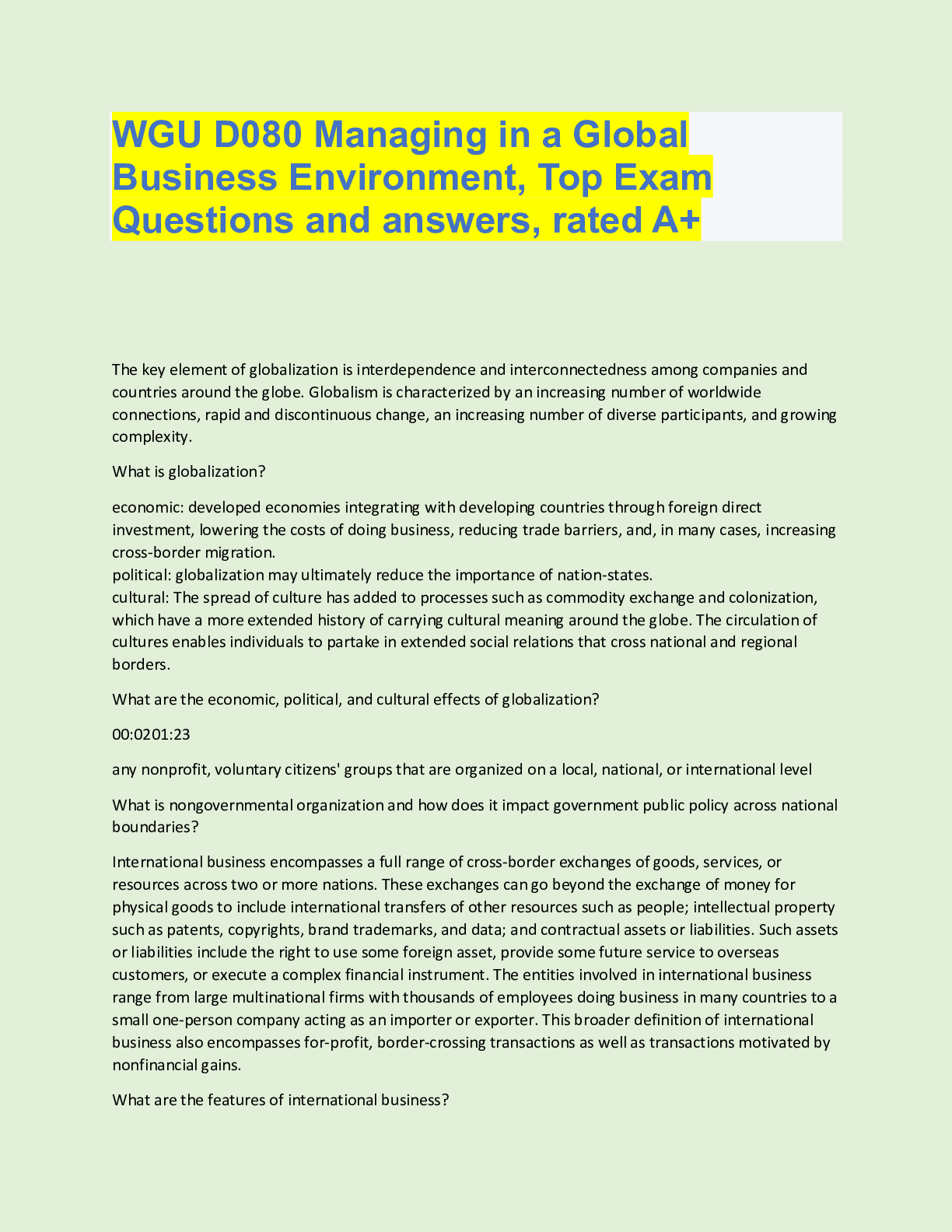
Reviews( 0 )
Document information
Connected school, study & course
About the document
Uploaded On
Mar 14, 2023
Number of pages
60
Written in
Additional information
This document has been written for:
Uploaded
Mar 14, 2023
Downloads
0
Views
63




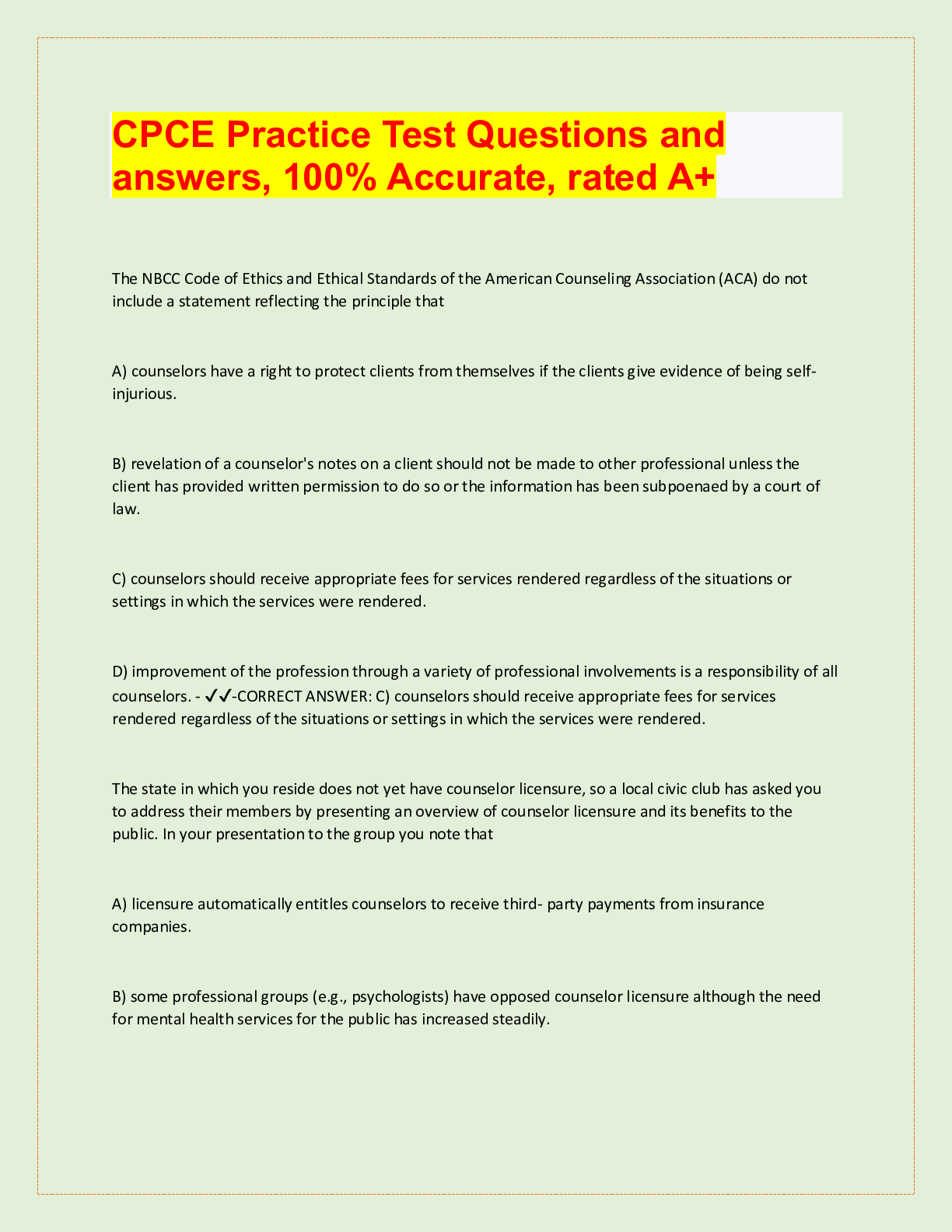


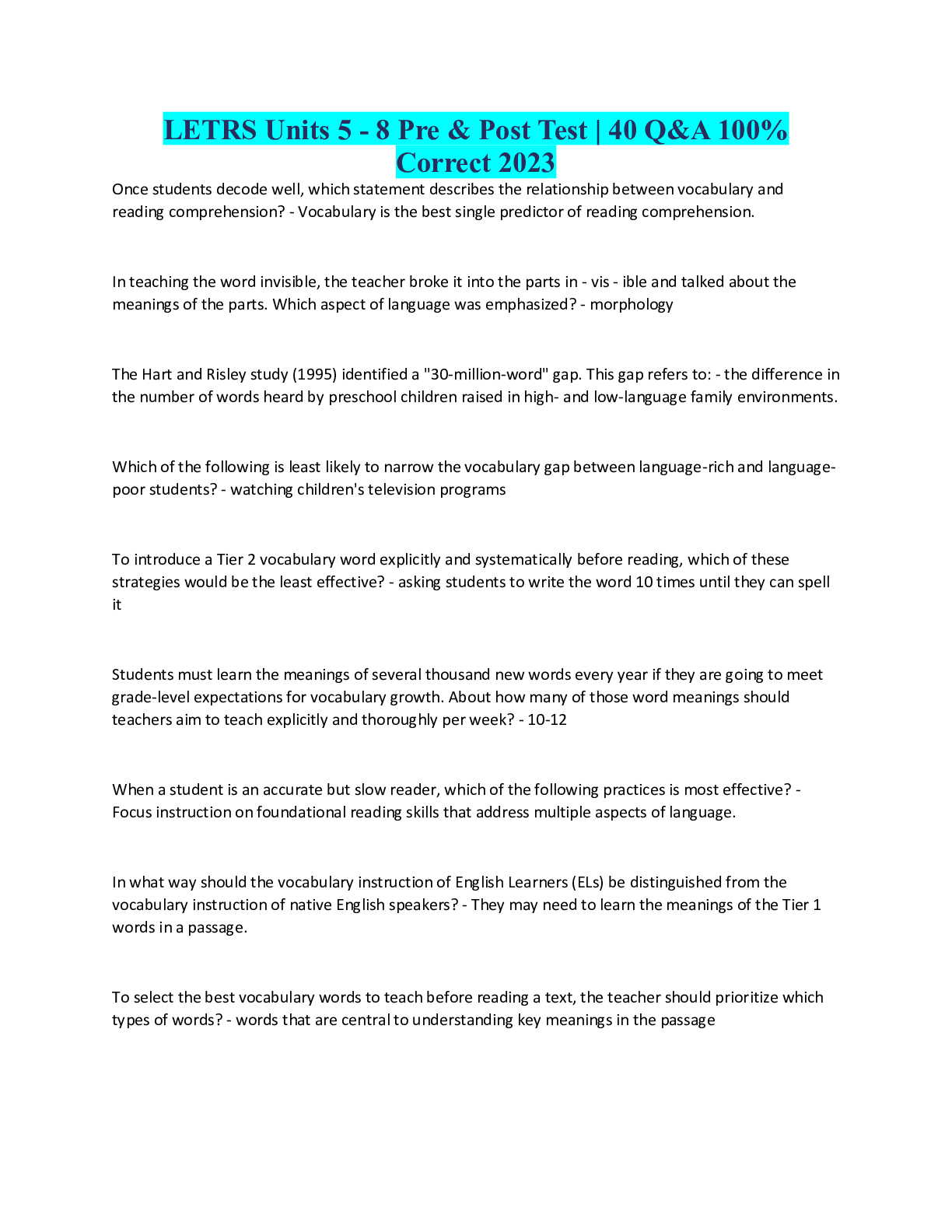
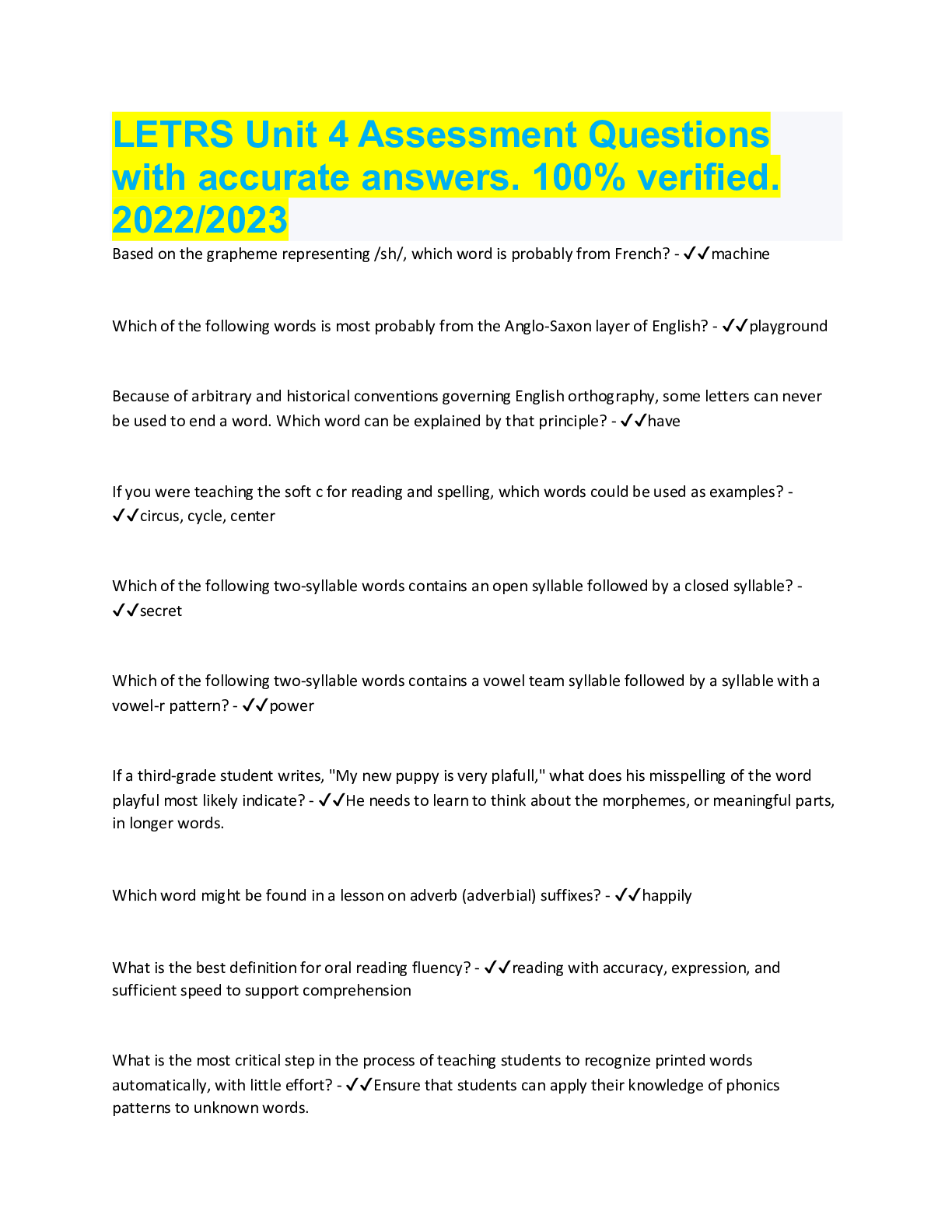
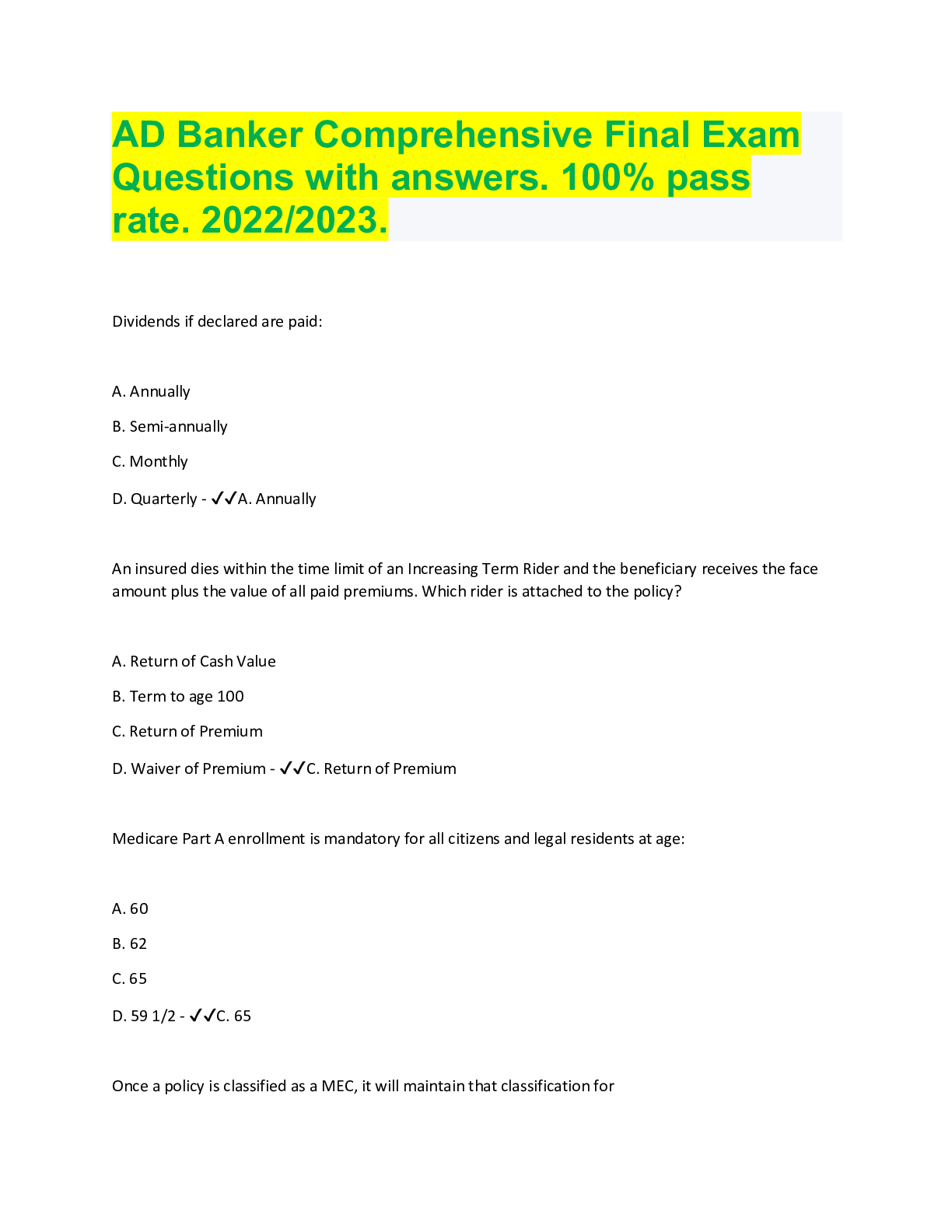




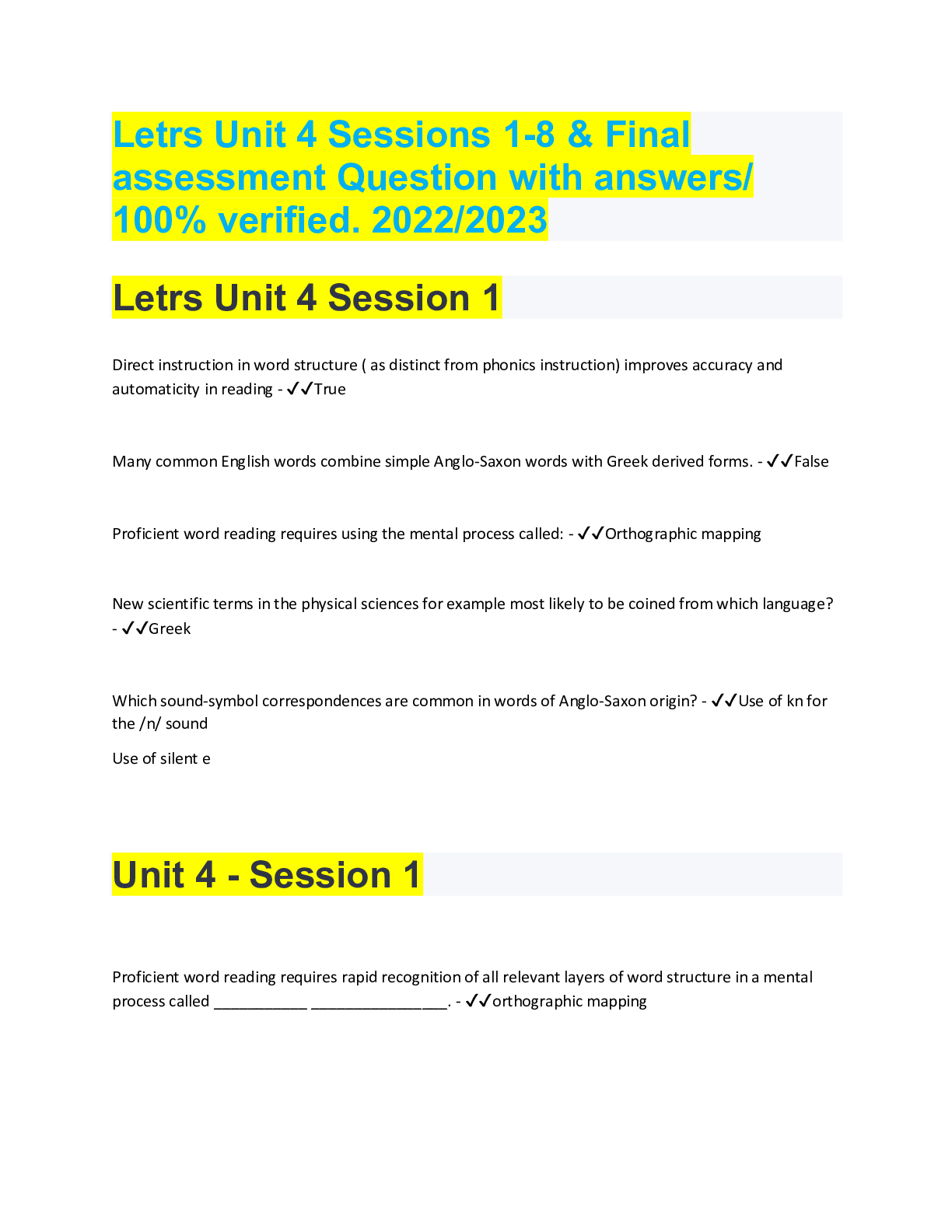
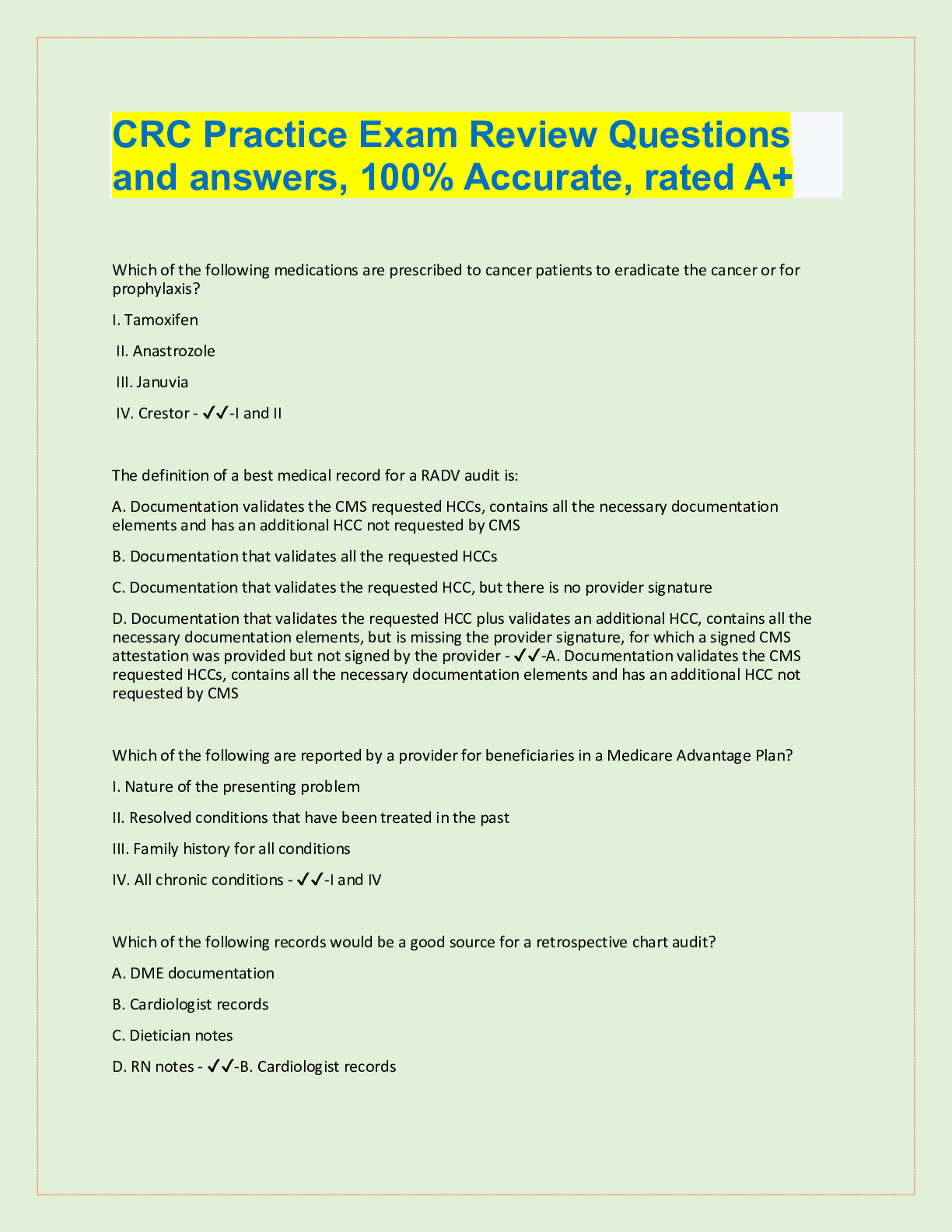
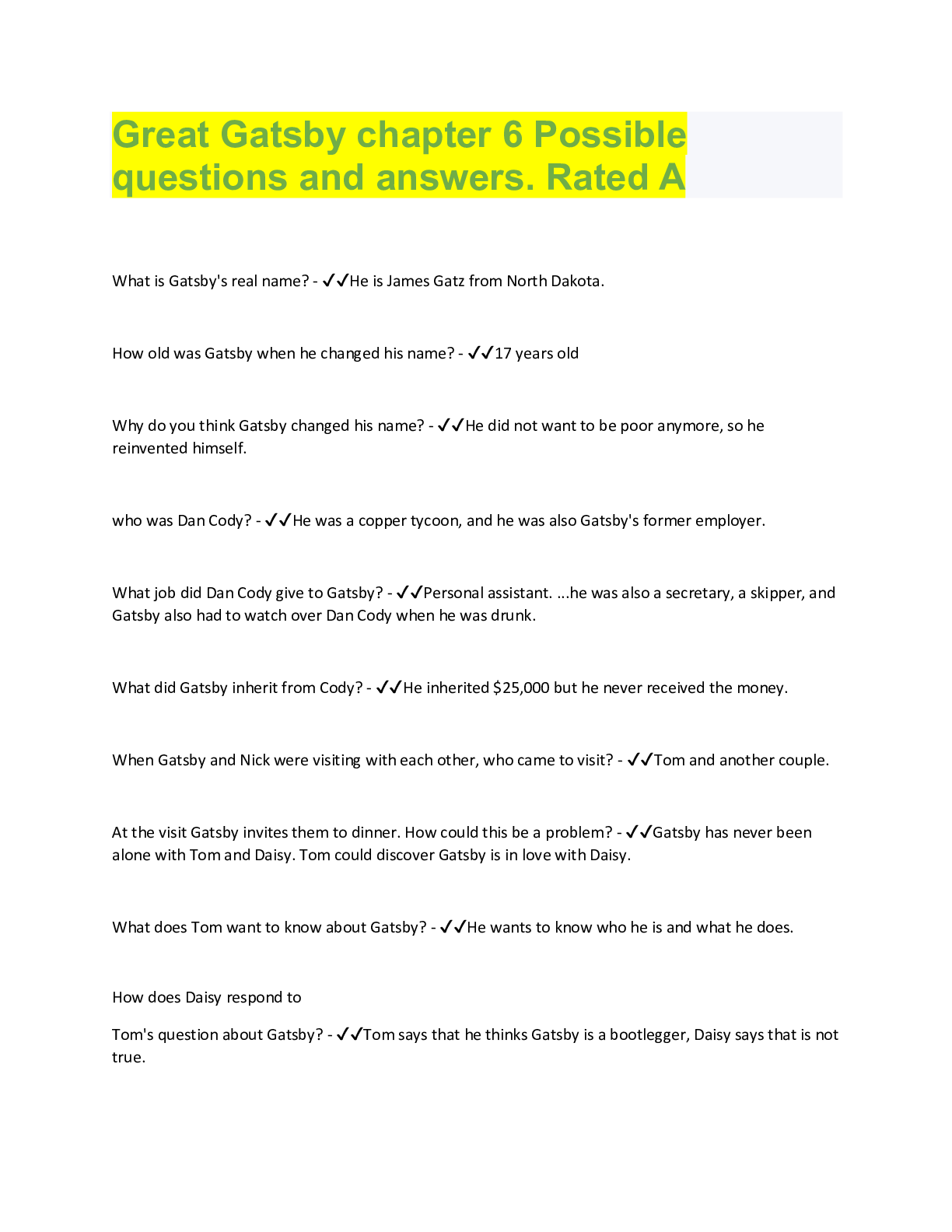
.png)
.png)
.png)
.png)
.png)
.png)
.png)





